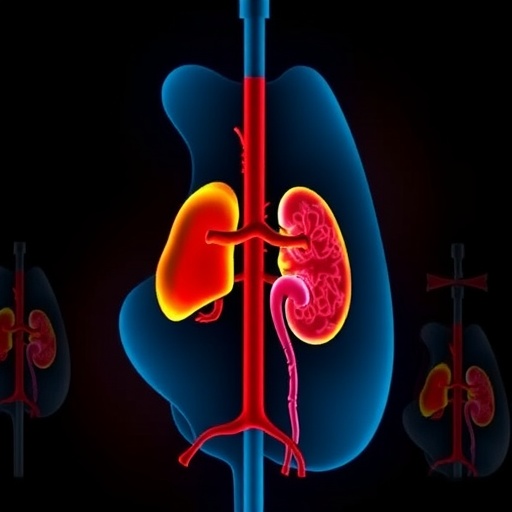In a landmark study poised to reshape our understanding of alcohol-associated liver diseases, researchers from the Indiana University School of Medicine and Regenstrief Institute have uncovered compelling evidence that a parental history of death due to liver disease drastically increases the risk of developing alcohol-associated hepatitis (AAH) in adult offspring. This severe form of liver injury, closely linked to chronic alcohol misuse, now carries an identifiable familial risk marker that may transform preventative strategies within clinical medicine.
Alcohol-associated hepatitis is notoriously one of the deadliest manifestations within the spectrum of alcohol-related liver disease. Each year, nearly 20,000 Americans succumb to complications arising from alcoholic liver injury, positioning AAH among the leading causes of liver-related mortality nationwide. Despite alcohol consumption being a well-established risk factor, why only certain heavy drinkers develop this acute inflammatory condition has remained elusive. The new findings inject a genetic and familial dimension into this puzzle, emphasizing the significant role that inherited susceptibility might play.
The study meticulously analyzed data pooled from two extensive multicenter cohorts encompassing individuals diagnosed with alcohol-associated hepatitis and heavy drinkers who had not developed substantial liver pathology. While parental alcohol use disorder (AUD) was prevalent in both groups, the critical determinant linked with heightened AAH risk was not simply a family history of AUD but specifically the death of a parent due to liver disease. This distinction nuances previous assumptions by highlighting that a fatal hepatic outcome in parents portends a greater vulnerability for children, possibly rooted in genetic or epigenetic underpinnings.
Understanding the pathophysiology of AAH involves recognizing its multifactorial etiology – a convergence of excessive ethanol-induced hepatocyte injury, aberrant immune responses, and inflammatory cascades leading to acute liver inflammation and dysfunction. Steroids remain the mainstay of treatment due to their anti-inflammatory properties, but their utility is limited by increased risks of infection and incompatibility in many patients. Consequently, preventative measures have surged to the forefront of clinical management, underscoring the import of early risk stratification.
What differentiates this study is its focus on familial mortality from liver disease as a prognostic and diagnostic insight rather than mere parental history of alcohol misuse. As Professor Wanzhu Tu, lead author and expert in biostatistics and health data science, elucidates, such information should not be disregarded during patient intake as trivial background but recognized as a critical red flag signaling genetic or hereditary predisposition. This revelation mandates a paradigm shift wherein clinicians integrate detailed family mortality data into their assessment algorithms to better identify at-risk individuals.
Beyond the initial development of alcohol-associated hepatitis, the research further demonstrated that patients harboring such family histories face a grimmer prognosis post-diagnosis. Specifically, a parental death from liver disease nearly doubles the risk of mortality within 90 days of AAH diagnosis, identifying family history as a strong predictor of adverse outcomes. These findings advocate for intensified monitoring, counseling, and potentially novel therapeutic interventions targeted at this high-risk patient cohort.
Dr. Samer Gawrieh, co-author and corresponding expert in hepatology, emphasizes the clinical utility of these insights in both prevention and treatment domains. Recognizing family history as a tangible risk marker can enable healthcare providers to tailor more aggressive alcohol cessation strategies and employ early intervention techniques. For patients already diagnosed, discussing familial patterns may serve as a motivational cornerstone for sustained abstinence and adherence to supportive care regimens, ultimately improving survival rates.
The implications of this study extend into the realm of genetics and epigenetics, opening avenues to investigate specific inherited variants or environmentally mediated gene expression modifications that might drive susceptibility. Whether the familial risk arises from single gene mutations, polygenic inheritance, or epigenetic reprogramming remains a critical question for future research endeavors. The interplay between genetic predisposition and environmental exposure to alcohol likely constitutes a complex biological symphony influencing disease penetrance.
Additionally, the research underscores the intricate relationship between hereditary factors and environmental stressors, such as socio-economic conditions, lifestyle, and psychosocial elements that cluster in families and modulate disease risk. Untangling these overlapping influences will be essential to refine predictive models and develop targeted therapies that take into account both genetic risk and modifiable external factors.
This investigation was rigorously conducted under the auspices of the National Institutes of Health, supported by two major collaborative consortia – the Alcoholic Hepatitis Network (AlcHepNet) and the Translational Research Evolving Alcoholic Hepatitis Treatment (TREAT) consortium – integrating expertise from multiple leading academic medical centers across the United States and Spain. Such multisite collaboration enhances the study’s robustness and generalizability of findings across diverse populations.
Published in the prestigious journal Hepatology Communications, the study is a call to action for clinicians, researchers, and public health authorities to incorporate family history into clinical workflows and to accelerate research aimed at elucidating the biological mechanisms underpinning hereditary vulnerability to alcohol-associated liver disease. This pivotal shift holds promise for more precise risk stratification, early interventions, and ultimately, reducing the devastating morbidity and mortality burden of alcohol-associated hepatitis.
In summary, the discovery that parental death from liver disease is a potent risk and prognostic factor for alcohol-associated hepatitis redefines our approach to this lethal condition. It highlights the necessity of comprehensive family health histories in clinical assessments and propels the field toward genetic and epigenetic explorations that may unlock novel preventive and therapeutic pathways. As the global burden of alcohol-related liver disease continues to rise, such integrative research efforts offer hope for halting the tide through informed, targeted clinical care.
Subject of Research: Alcohol-associated hepatitis risk and outcomes related to parental liver disease mortality
Article Title: Parental liver disease mortality is associated with unfavorable outcomes in patients with alcohol-associated hepatitis
News Publication Date: 1-Jun-2025
Web References: 10.1097/HC9.0000000000000666
References:
Tu W., Gawrieh S., Nephew L., et al. Parental liver disease mortality is associated with unfavorable outcomes in patients with alcohol-associated hepatitis. Hepatology Communications. 2025; DOI: 10.1097/HC9.0000000000000666.
Keywords: Alcohol-associated hepatitis, familial risk, liver disease mortality, genetic susceptibility, alcohol-related liver disease, epidemiology, biostatistics, hepatology, prevention, NIH-funded research




